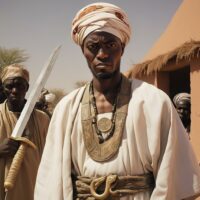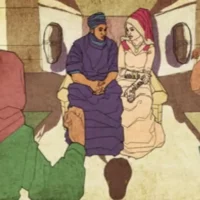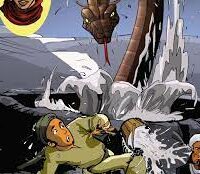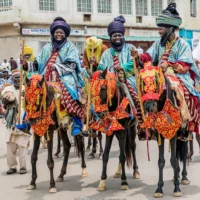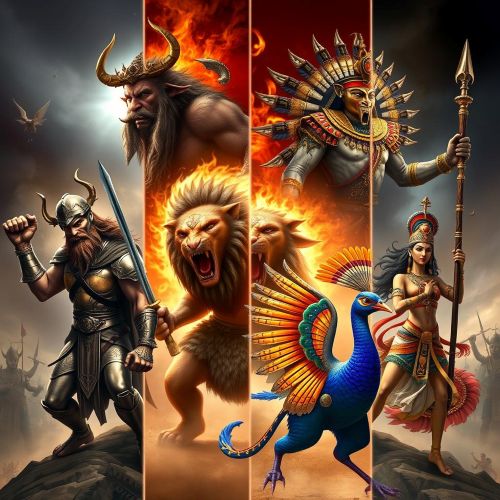Bayajidda : The Hausa Founder
Listen
At a glance
| Description | |
|---|---|
| Origin | Hausa Mythology |
| Classification | Gods |
| Family Members | Daurama (Wife). Bawo (Son), Biram (Son) |
| Region | Nigeria |
| Associated With | Founding Cities |
Bayajidda
Introduction
Bayajidda is a central figure in Hausa mythology, embodying bravery, intrigue, and divine intervention, and his legend is intricately woven into Hausa culture and history. His story, blending folklore, history, and myth, reflects the values and beliefs of the Hausa people. Synonymous with the origin tale of the Hausa states, Bayajidda’s enduring legacy as a mythical ancestor and symbol of unity transcends debates about his historical existence. Originating from Baghdad, he journeyed to the Hausa region, where his heroic deeds established him as a legendary figure in Hausa folklore.
Physical Traits
Descriptions of Bayajidda’s physical appearance in Hausa mythology emphasize his formidable and heroic attributes. Typically depicted as tall, strong, and handsome, he exudes an aura of invincibility, with eyes that gleam with a supernatural light, symbolizing his bravery. Portrayed with an athletic build, his prowess in combat and endurance on arduous journeys are evident. These physical traits not only highlight his outer strength but also reflect his inner fortitude and the extraordinary nature of his mission. While specific details may vary across narratives, Bayajidda is consistently depicted as a figure of imposing stature, possessing the strength, agility, charisma, and intelligence necessary to accomplish legendary feats like slaying the serpent in Kusugu.
Family
Bayajidda’s family played a pivotal role in the establishment of the Hausa states. Married to Daurama, the queen of Daura, he had a son named Bawo. From his first wife, the daughter of the ruler of the Borno empire, he had another son named Biram, while a concubine bore him a third son. Bawo later fathered six sons who, alongside their uncle Biram, ruled the seven legitimate Hausa states: Daura, Kano, Katsina, Zaria, Gobir, Rano, and Hadeja. Bayajidda’s family lineage is integral to his legend, portraying him as a foreign prince, possibly of Arab descent.
Arriving in Bornu, he married Daurama before conflicts led him to Daura, where he encountered and vanquished a mythical serpent. This act earned him the favor of Daura’s queen, Magajiya, whom he married, leading to the birth of the founders of the seven legitimate Hausa states. Bayajidda’s relationships with his wives and children, particularly Bawo and Biram, are significant aspects of his tale, symbolizing the origins of both the legitimate and illegitimate Hausa states.
Other names
While “Bayajidda” is the most common name, it holds symbolic meaning. Some interpretations translate it as “Ba ya ji da,” signifying his initial struggles adapting to Hausa culture due to his foreign origins. Another theory links it to Abu Yazid, a historical rebel.
Variations abound. Local pronunciations and dialects influence spellings, with “Abuyazidu” being a common variant. He’s also known as “Bàyā̀jiddà” in Hausa and sometimes the “Prince of Baghdad” depending on the region and legend version. This multiplicity of names reflects the widespread influence of his legend and its adaptation across the Hausa-speaking world.
Powers and Abilities
Bayajidda’s heroism transcends mere physical prowess. Slaying the Daura serpent exemplifies his courage, resourcefulness, and unwavering commitment to protecting his people. This act, and others like it, solidify him as a foundational figure in Hausa society. His journey from Baghdad is a testament to his strategic mind and combat skills. He skillfully navigates challenges and encounters, showcasing his leadership potential. These attributes, along with his legendary bravery, are crucial for his role as founder of dynasties and states. Some versions of the legend portray Bayajidda as possessing a deep sense of justice, reflected in decisions that prioritize the well-being of his people. This further elevates him to the status of a wise and benevolent leader.
In essence, Bayajidda is revered for a combination of exceptional qualities. He possesses the physical strength to overcome adversity, the intelligence to navigate complex situations, and the charisma to unite diverse groups. Perhaps his most profound ability is fostering unity. Through marriage to Hausa royalty and fathering the founders of the seven states, Bayajidda becomes a symbol of the merging of ethnicities and the birth of a unified Hausa identity.
Modern Day Influence
Bayajidda, the legendary ancestor of the Hausa people, transcends mere myth. His courage and resourcefulness, exemplified by slaying the Daura serpent, solidify him as a foundational figure. His journey and leadership qualities further solidify his role as a state founder. This heroic persona is celebrated in festivals, adorns murals, and serves as a call for unity in a diverse region.
However, the legend isn’t without controversy. The emphasis on a foreign origin story downplays the role of indigenous Hausa people. Additionally, the division of states based on Bayajidda’s marriages raises questions about social hierarchy.
Despite these critiques, Bayajidda’s story remains a cornerstone of Hausa identity. It’s a shared narrative connecting them to their roots, reinforced through festivals, storytelling, and education. His image appears in media, and the social structures of Hausa states reflect the legend’s influence. Bayajidda’s legacy endures as a testament to the power of myth in shaping cultural identity.
Related Images
Frequently Asked Questions
What is lorem Ipsum?
I am text block. Click edit button to change this text. Lorem ipsum dolor sit amet, consectetur adipiscing elit. Ut elit tellus, luctus nec ullamcorper mattis, pulvinar dapibus leo.
What is lorem Ipsum?
I am text block. Click edit button to change this text. Lorem ipsum dolor sit amet, consectetur adipiscing elit. Ut elit tellus, luctus nec ullamcorper mattis, pulvinar dapibus leo.
What is lorem Ipsum?
I am text block. Click edit button to change this text. Lorem ipsum dolor sit amet, consectetur adipiscing elit. Ut elit tellus, luctus nec ullamcorper mattis, pulvinar dapibus leo.
What is lorem Ipsum?
I am text block. Click edit button to change this text. Lorem ipsum dolor sit amet, consectetur adipiscing elit. Ut elit tellus, luctus nec ullamcorper mattis, pulvinar dapibus leo.
What is lorem Ipsum?
I am text block. Click edit button to change this text. Lorem ipsum dolor sit amet, consectetur adipiscing elit. Ut elit tellus, luctus nec ullamcorper mattis, pulvinar dapibus leo.

